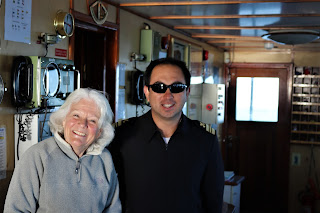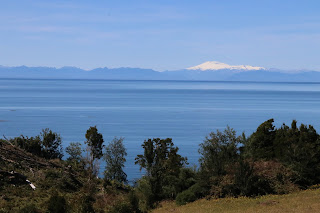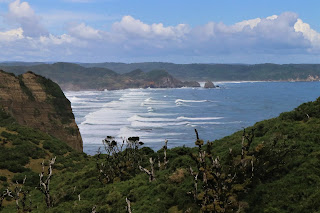Having
completed a major stretch of the scenic Carretera Austral we were given to
understand that we should leave it before Villa Santa Lucia due to the road
being blocked there by a landslide. We
were informed that we would be required to drive to the small fishing village
of Raul Marin Balmaceda where we could catch a ferry north to Chaiten, thus
circumnavigating the road block, or possibly direct to the island of Chiloe,
our next destination.
Booking
a ferry was not made particularly easy. We
tried to make a booking at Puyuhuapi with the assistance of Andrea, the
delightful lady at the shop where we had hired the kayaks. She phoned the ferry company on our behalf
only to be told that they would only take bookings by email which we duly did
but then got no response.
We set
off from Puyuhuapi anyway on Monday 26th February and drove 70
kilometres north to La Junta, the turn off from the Carretera Austral. We stopped briefly for lunch and a further
attempt to book the ferry, but the Tourist Information was closed and there was
no ferry booking office.
We set
off again, this time along a rather bouncy dirt road but through beautiful
countryside with lakes, rivers and mountains covered in snow at the tops, and
then the road stopped beside a wide river about 500 metres across. There was a ferry on the other side of the
river and we weren’t sure whether it would come over to our side, but it did,
and it took us across for free.
After
a little bit more bouncing around on the winding dirt road we arrived at the
tiny settlement known as Raul Marin Balmaceda, and we ultimately got to the
ferry booking office which by a great stroke of fortune was also the shop, the
hotel and the restaurant. All this was
ministered by an extremely fat and jolly woman who was unfailingly helpful.
We
started to understand why we hadn’t been able to book the ferry when said jolly
lady informed us that she was far too busy running the shop/hotel/restaurant to
answer emails!
Our
preference would have been to catch a ferry direct to Chiloe but we were told
there are only two sailings a week and they were fully booked for some time
ahead so we settled for the seven hour ferry trip north to Chaiten, from where
we would catch another four hour ferry to Chiloe.
We got
on the ferry for Chaiten at seven o’clock on Tuesday morning. This was a free ferry and it looked it, it
was a real rust bucket with rust coming through all over the place. The
access ramp was interesting, high in the middle and low on either side and
there was quite a turn to get onto the boat at the bottom. There were no guard rails whatsoever and if
you were unwary you could finish up in the bay, but we didn’t. In fact,
health and safety didn’t really seem to apply at all. Far from the car deck being inaccessible
whilst the vessel was at sea we were able to come and go as we pleased and many
of the vehicles had occupants fast asleep inside them!
The
boat trip turned out to be an unexpected delight. It was a beautiful day, the sun shone and
illuminated the ice fields on the far off mountains and, whilst we were still
in the shelter of the bay, the occasional penguin popped up and then disappeared
again.
Rust bucket
Early morning light on the ferry to Chaiten
Distant view of snow capped Andes
Morning mist off west coast of Chile
Sue with El Capitan of rust bucket
Salt marsh at Chaiten with view of distant mountain
Lunch stop at national park near Chaiten
The park ranger greeted us enthusiastically and was very articulate about all the delights on offer in the park. This was entirely in Spanish which was a bit of a waste on Alan, but Sue and the ranger chatted and we soon understood what we could do and where we could camp.
Following
the ranger’s recommendation we went for a walk down by the side of the Rio
Yaldad through what seemed like an enchanted forest. This forest is a temperate rainforest but it
is so lush and full of fecundity that you felt that if you stood still for half
an hour or so you would take root and leaves would start sprouting from your
head.
The trails were impeccably laid out and as we walked the ground underfoot was springy with leaf litter and wood detritus, the trees were clad in mosses, in fungi and in various parasitic plants, some of which had beautiful flowers on them. Some of the trees were clad in ferns and in some cases the entire tree trunk was six inches deep in moss and ferns way up as far as you could see into the canopy of the forest.
Local flora
Within
the forest there were a number of birds including the redoubtable Chucao. This is a small bird with a loud voice, with
a tail like a wren but the salient feature is that it cannot fly or maybe, like
Tigger, it can but it doesn’t want to.
The wings are short and stubby and it appears able to use them to help
propel its body from roost to roost and across pieces of open ground but
certainly it doesn’t fly.
Chucao in the enchanted forest
It took us about three hours to walk from the ranger’s station to the end of the trail and just over an hour to walk back along the main track. On the way back we happened across a bunch of Chilote foxes. They looked like half-grown cubs and were almost completely unafraid but they had all the foxy attributes and we found them rather cute until we got back to the ranger station and sat down to have a sandwich. Then the little buggers came along and not only did they try and scam a meal but one of them bit Alan’s foot and another one jumped up and had a go at the crisps that Sue was nursing at the time. Not so cute after all!
After lunch we set off for the campsite, about an hour’s drive along bouncy dirt road through the forest. The following day we walked a couple more of the well laid out trails and took a double kayak out on the nearby lake. However, we found the lake to be pretty sterile with very little on it apart from a few ducks.
Snug as a bug in a rug at the campsite
On Saturday 3rd March we left Tantauco park and drove about 70 kilometres north to Castro, a lively town which is situated at the head of a fjord on the east side of Chiloe. We found a very nice cabana right next to the fjord a few kilometres south of the town and, having discovered that it made a very good base from which to explore the eastern side of the island, we stayed for six days.
Castro
is quite a gritty place, somewhat rough around the edges (a bit like Barnsley
according to Alan), it’s busy, there are lots of people milling around and
there is a great sense of the buzz of humanity.
Wooden church, Castro
One of the most charming features of Castro are its traditional ‘palafitos’, brightly coloured shingled fishermen’s houses on stilts perched precariously above the water. The idea was that you could moor your boat at your back door and walk out onto the street through the front one.
Fishermen's houses, Castro
Fishermen's houses
Fishermen's houses and black neck swans
Fishermen's houses
Hudsonian Godwits - on shoreline next to our cabana
Besides
Castro, we spent our time exploring the small villages and hamlets along the
coastline. Usually this involved leaving the main road and following a steep
winding road down to the seashore.
Sometimes there were a few houses with one or two people gathering and
drying kelp, and sometimes there was nothing but a shingly beach. The beaches were very peaceful and appeared
at first sight to be deserted but were in fact full of bird life and we much
enjoyed them.
Pigs enjoying mussels on the shoreline
Whimbrel
Chimanga Caracara enjoying mussels
Kelp harvester in happy mood
Herding cattle on Chiloe seashore
Wooden church, Chiloe
Seashore, Chiloe
Distant view of Andes from Chiloe
Wooden church, Chuchao
We
also visited Isla Lemuy and Isla Quinchao, two of the smaller islands of the
Chiloe archipelago, both easily reached in ten minutes on a car ferry.
Lemuy
is a lovely little island, dotted with rural settlements, and it has the
distinction of having three out of Chiloe’s sixteen UNESCO churches. These are very large wooden churches, the
outsides of which are generally very bare apart from a bell tower and an open
fronted portico. A couple of them were
propped up on one side and not in very good condition but they were interesting
and we were pleased to have seen them.
UNESCO World Heritage Church
Mourners shelter in graveyard
Close up - local building technique
Quinchao
was also interesting, the first village had a pretty plaza and many of its
houses were made of traditional wooden architecture with wood shingle walls. It
had a market selling artisan woollies which looked like the sort of thing that
you might send off to a refugee camp and certainly they were a bit shapeless,
so we didn’t buy any.
In Achao, the second fishing village, we went into the market and an old crone gave Alan a very spikey fruit which had bits that you pulled out of the middle, a bit like a globe artichoke, and then you sucked the white ends of it and spat out the black seeds. We have no idea what it was but it least it wasn’t poisonous!
In Achao, the second fishing village, we went into the market and an old crone gave Alan a very spikey fruit which had bits that you pulled out of the middle, a bit like a globe artichoke, and then you sucked the white ends of it and spat out the black seeds. We have no idea what it was but it least it wasn’t poisonous!
The old man, not quite sure about the spikey fruit
We need to say a little about the unique folklore and mythology in Chiloe where there is still apparently a widespread belief in witches, particularly in the remote rural areas. Here are a few examples of the supernatural beings which inhabit the archipelago:
Brujo
is the generic term for a witch. There are only male witches and their
legendary cave is rumoured to be near the village of Quicavi. To become a witch you have to assassinate a
loved one and make a purse out of their skin.
Caleuche
is a ghostly ship that glows in the fog, travels at great speed both above and
below the water and carries witches to their next stop. It’s crewed by shipwrecked sailors and
fishermen who have perished at sea.
Invunche
was stolen at birth by witches and raised on the flesh of the dead and
transformed into a deformed monster with one crooked leg behind his back. He is the one that guards the entrance to the
witches’ cave. We doubt that he is much good in hot pursuit, though!
Pincoya
is a fertility goddess of extraordinary beauty.
She is the one that is responsible for the abundance or scarcity of fish
in the sea. She dances half naked draped
in kelp on the beaches. If you see her
facing the sea the village will get lots of fish, if she is looking towards the
land there will be a shortage.
Trauco
is a deformed and ugly troll who lives in the forest. He carries a stone axe and his breath makes
him irresistible to women and therefore he gets blamed for all the unexplained
pregnancies on the island. (And if you believe that…….).
In
spite of keeping our eyes peeled we never came across any witches or trolls but
representations of these mythological creatures were evident all around us in
Castro. There were statues, souvenirs in the artisan markets, ugly creatures
painted on shop hoardings and a few of the locals came close.
Statue of Pincoya in Castro square
We left Castro on Friday 10th March and headed across to the west coast which was not very far as Chiloe is a long narrow island. The sea here is, of course, the Pacific but it was anything but pacific. Big wide crashing combers came in like waves of an army, much the same as we experienced on the Mexican coast nearly two years ago.
Our first destination was ‘The Bridge to Nowhere’ out on a remote headland. Legend has it that this part of the island acts as a bridge between this world and the next with the souls of the dead calling out to the boatman to ferry them across. An enterprising landowner has built a symbolic Muelle de las Amas (pier of souls) on the headland that ends halfway to illustrate the legend.
From
here we made our way to the Chiloe National Park, another vast area of
protected forest and we spent a happy couple of days walking the trails through
the forest and also the nearby sand dunes and beach.
Campsite in Chiloe National Park
Chiloe is renowned for it’s terrible weather and we experienced the sort of rain that we were told to expect whilst we were camping in the park. On our second day it hammered it down from about 4.30 pm until the following morning. We retreated into the cockpit of Lucy where we got the heater going, sank a few glasses of wine and ate our supper in relative comfort.
Our
last couple of days on Chiloe were spent in the northern town of Ancud where it
continued to rain for most of the time. This time we had a nice cosy cabana
with a lovely wood burning stove. In between the rain storms we managed a boat
trip out to a penguin colony and also to an area of wetland. This was created
in 1960 when a tsunami caused by the most powerful earthquake ever recorded
(9.5 on the Richter scale) flooded a section of coastal forest. The wetland is
said to be a haven for birds but apart from a kingfisher, a solitary heron and
a few cormorants we drew a blank. And to add insult to injury it hammered it
down.
Wide sandy beach with river estuary, near Ancud
Penguin colony
Penguin colony
Rock cormorants at the Penguin colony
Male Collared Kingfisher, Chepu Valley wetland
This morning, Wednesday 14th March, we got on another ferry and left Chiloe to join the mainland once more. And so we continue onto the next chapter.




















































No comments:
Post a Comment